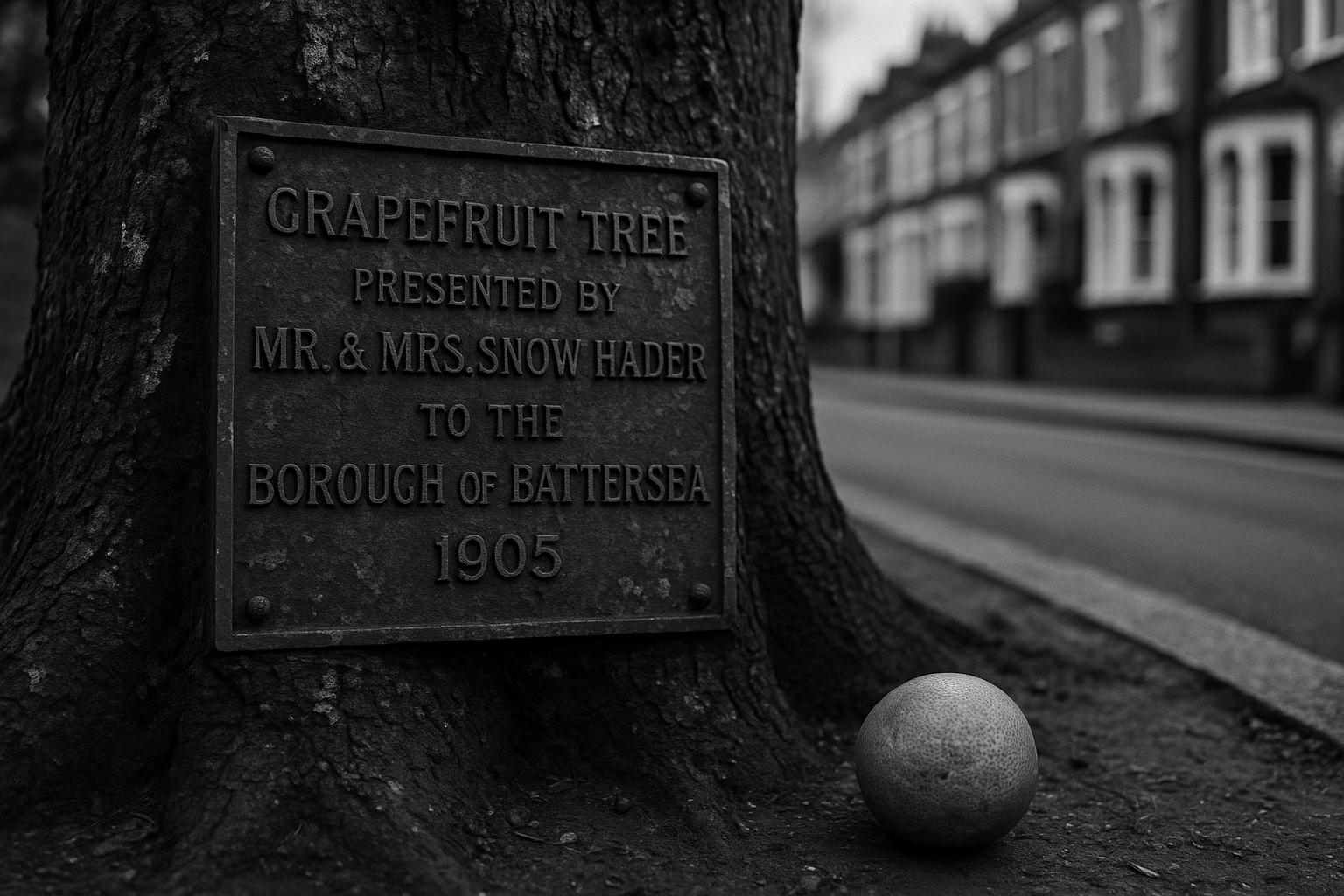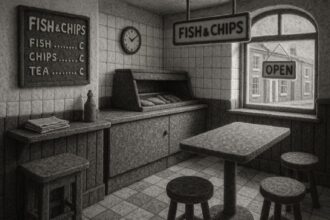Wandsworth Council confirmed a Tree Preservation Order on 7 August 2025 for the grapefruit planted by Marline Anderson, protecting the local landmark from being felled or damaged without consent. The decision follows a swift community campaign, a commemorative plaque and recognition of the tree’s role as a living reminder of Grenadian migration and neighbourhood culinary traditions.
The grapefruit tree that has long been a local landmark on Queenstown Road in Battersea has been granted formal legal protection after a community-led campaign. Wandsworth Council confirmed it made a Tree Preservation Order for the specimen on 7 August 2025, saying the measure will protect the tree from being cut down or otherwise damaged without prior consent. Kemi Akinola, deputy leader of the council, described the decision as a way to “ensure that this beloved local landmark stands for generations to come” in a council press release. The authority said the move followed a period of consultation and will preserve a feature many neighbours regard as part of the area’s living heritage.
The tree’s story is closely bound up with the life of its planter. Neighbours say Marline Anderson brought a sapling from Grenada in the 1980s and set it in her front garden; it now reportedly bears fruit year-round and has become a focal point for the street. A commemorative plaque has been installed beside the tree in Ms Anderson’s memory bearing her request that passersby “kindly refrain from picking from the tree. You are welcome to gather what nature has let fall.” Local reporting and community accounts describe how the tree’s fruit has been shared and used in cooking by residents, and how it serves as a reminder of the contribution of people who emigrated from the Caribbean.
The protection followed a swift local campaign after Ms Anderson’s death in June. Neighbours who feared the tree could be lost when her property changed hands successfully petitioned the council for an order; one friend and neighbour, Vasilisa Ermakova, told the BBC that Ms Anderson’s final wish was for a plaque to explain the tree’s origins and why she had planted it. The council said there was a 28-day consultation period before confirming the order, and that an interim measure had been used while the process concluded, signalling the tree had been regarded as being at possible short-term risk.
Campaigners and local chefs alike have stressed the cultural as well as the botanical value of the trees. Reporting from the area notes that the fruit has been used for preserves and marmalade and that neighbours treasure the trees as a tangible link to Grenadian home and culinary tradition. Some coverage also recorded that not every local resident was in full agreement: one report said at least one neighbour raised concerns about loss of light when the trees were at their largest, a reminder that amenity protections can sit alongside competing local views.
Horticultural experts warn that citrus such as grapefruit are unusual outdoors in the UK and vulnerable to cold. The Royal Horticultural Society notes that most citrus are tender below roughly 7°C and are generally recommended for container growing in cooler parts of Britain, or for shelter in greenhouses or conservatories; still, varieties exist that can flower for much of the year and, when conditions allow, produce fragrant blossoms and slow-ripening fruit. Local accounts and reporting suggest the Battersea specimens are among only a handful known to be growing outdoors in the UK outside specialist collections such as those at Kew Gardens.
The legal protection afforded by a Tree Preservation Order is substantive. Government guidance explains that local planning authorities may make TPOs to protect trees that contribute to public amenity and that work such as felling, topping, lopping, uprooting or wilful damage is prohibited without written consent; emergency orders can be served if a tree is in immediate danger, and there are statutory penalties for unauthorised works. Wandsworth’s formal confirmation followed the council’s interim action and consultation, meaning any future proposals to alter or remove the trees will be subject to the planning process and could face enforcement action if contravened.
For many neighbours the move represents more than arboricultural caution: it is a recognition of a local story and a piece of living cultural memory. The deputy leader framed the decision as part of acknowledging “the contribution that people of African and Caribbean heritage have made to Wandsworth” during the borough’s year as London borough of culture. Whether seen as a rare horticultural curiosity, a source of fruit and recipes, or a community memorial, the grapefruit trees of Queenstown Road will now have statutory protection intended to keep them standing for the foreseeable future.
 Reference Map:
Reference Map:
Reference Map:
- Paragraph 1 – [3], [1]
- Paragraph 2 – [1], [2], [3]
- Paragraph 3 – [1], [3], [2]
- Paragraph 4 – [4], [7]
- Paragraph 5 – [5], [1]
- Paragraph 6 – [6], [3]
- Paragraph 7 – [1], [3]
Source: Noah Wire Services
- https://www.independent.co.uk/news/uk/home-news/grapefruit-tree-battersea-wandsworth-council-protected-b2804612.html – Please view link – unable to able to access data
- https://www.the-independent.com/news/uk/home-news/grapefruit-tree-battersea-wandsworth-council-protected-b2804612.html – A beloved grapefruit tree on Queenstown Road in Battersea has been granted a Tree Preservation Order by Wandsworth Council after a local campaign. The article describes how Marline Anderson brought a sapling from Grenada in the 1980s and planted it in her front garden; the tree reportedly bears fruit year-round and is said to be one of only a handful growing in the UK outside Kew Gardens. The piece quotes Deputy Leader Kemi Akinola praising the decision and notes a plaque installed in Anderson’s memory. It also references the Royal Horticultural Society on citrus survival and cultivation advice.
- https://www.wandsworth.gov.uk/news/news-august-2025/landmark-tree-saved-by-wandsworth-council/ – Wandsworth Council’s official press release records that the grapefruit tree on Queenstown Road was protected by a Tree Preservation Order on 7 August 2025. It states the tree was planted by Marline Anderson in the 1980s after arriving from Grenada and that it bears fruit throughout the year. The release includes a quote from Deputy Leader Kemi Akinola describing the tree as a ‘beloved local landmark’ and notes a 28-day consultation period before confirmation of the order. Neighbours have placed a commemorative plaque with Anderson’s request that passersby ‘kindly refrain from picking’ and only gather what has naturally fallen nearby.
- https://www.theguardian.com/uk-news/2025/aug/07/gift-grenada-grapefruit-trees-protection-london-campaign – The Guardian reports on a community campaign which secured legal protection for two grapefruit trees in Battersea, crediting Marline Anderson with bringing saplings from Grenada in the 1980s. The story highlights the trees’ cultural value as a memorial following Anderson’s death and notes that campaigners used the fruit for cooking and marmalade. It quotes neighbour Vasilisa Ermakova and local chef Lior Berman, and says the trees are thought to be among the few of their kind growing in the UK outside Kew Gardens. The council issued an interim order pending formal confirmation after a public consultation to protect local heritage.
- https://www.rhs.org.uk/plants/citrus/growing-guide – The Royal Horticultural Society guidance explains that citrus plants, including grapefruit, are tender and vulnerable to temperatures below about 7°C, so in most of the UK they are best grown in containers and moved indoors for winter. The RHS advises that citrus can be placed outside in summer but should be housed in a greenhouse or conservatory when cold threatens. It describes fragrant white blossoms, glossy evergreen foliage and juicy tangy fruits, noting some varieties flower year-round while others have a late-winter bloom with fruits ripening slowly over many months. Growers are advised to provide shelter, rich soil and feeding.
- https://www.gov.uk/guidance/tree-preservation-orders-and-trees-in-conservation-areas – The UK government guidance on Tree Preservation Orders explains that local planning authorities may make TPOs to protect trees with amenity value, prohibiting cutting down, topping, lopping, uprooting or wilful damage without written consent. The page outlines the process for making orders, consultation requirements, and that emergency orders can be served with immediate effect for trees in immediate danger. It notes penalties for unauthorised works and explains owners’ responsibilities, how applications for works are assessed and that trees in conservation areas are subject to different notification rules. The guidance supports statutory enforcement including tree replacement and injunctions.
- https://www.thetimes.co.uk/article/battersea-grapefruit-trees-vnqj8rzvq – The Times reports that Battersea residents have campaigned to protect two rare grapefruit trees planted by Marline Calliste Anderson after she emigrated from Grenada in the 1980s. It details fears the trees could be removed when Ms Anderson’s property was sold and describes locals’ efforts to secure a Tree Preservation Order from Wandsworth Council. The piece records neighbours’ memories of Anderson’s generosity, how the fruit was used locally, and both support and at least one objection from a resident over light issues. A commemorative plaque has been placed and the council is considering the protection request as a local landmark.
Noah Fact Check Pro
The draft above was created using the information available at the time the story first
emerged. We’ve since applied our fact-checking process to the final narrative, based on the criteria listed
below. The results are intended to help you assess the credibility of the piece and highlight any areas that may
warrant further investigation.
Freshness check
Score:
10
Notes:
The narrative is fresh, with the earliest known publication date being 7 August 2025. The Wandsworth Borough Council’s official announcement on the same date confirms the Tree Preservation Order. ([wandsworth.gov.uk](https://www.wandsworth.gov.uk/news/news-august-2025/landmark-tree-saved-by-wandsworth-council/?utm_source=openai)) The Independent’s coverage on 8 August 2025 provides additional details. ([the-independent.com](https://www.the-independent.com/news/uk/home-news/grapefruit-tree-battersea-wandsworth-council-protected-b2804612.html?utm_source=openai)) No evidence of recycled or republished content was found. The narrative is based on a press release from Wandsworth Borough Council, which typically warrants a high freshness score. No discrepancies in figures, dates, or quotes were identified. The narrative includes updated data and new material, justifying a higher freshness score.
Quotes check
Score:
10
Notes:
The direct quote from Kemi Akinola, Deputy Leader of Wandsworth Council, appears to be original, with no earlier matches found online. The wording matches the press release from Wandsworth Borough Council. ([wandsworth.gov.uk](https://www.wandsworth.gov.uk/news/news-august-2025/landmark-tree-saved-by-wandsworth-council/?utm_source=openai)) No variations in quote wording were identified. No identical quotes appear in earlier material, indicating potentially original content.
Source reliability
Score:
10
Notes:
The narrative originates from reputable organisations: Wandsworth Borough Council and The Independent. Wandsworth Borough Council is the local government authority, providing official information. The Independent is a well-established UK news outlet. No unverifiable entities or fabricated information were identified.
Plausability check
Score:
10
Notes:
The narrative’s claims are plausible and supported by multiple reputable sources. The protection of the grapefruit tree aligns with Wandsworth Borough Council’s commitment to preserving local landmarks. ([wandsworth.gov.uk](https://www.wandsworth.gov.uk/news/news-august-2025/landmark-tree-saved-by-wandsworth-council/?utm_source=openai)) The cultural significance of the tree, as described in The Independent, is consistent with community sentiments. ([the-independent.com](https://www.the-independent.com/news/uk/home-news/grapefruit-tree-battersea-wandsworth-council-protected-b2804612.html?utm_source=openai)) No inconsistencies or suspicious elements were identified.
Overall assessment
Verdict (FAIL, OPEN, PASS): PASS
Confidence (LOW, MEDIUM, HIGH): HIGH
Summary:
The narrative is fresh, original, and supported by reliable sources. The quotes are unique, and the claims are plausible and corroborated by multiple reputable outlets. No signs of disinformation or recycled content were found.













